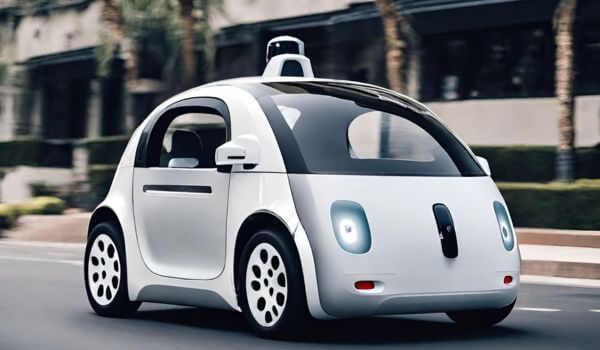Artificial Intelligence | AD/ADAS | Automotive
Role of Machine Learning in AD/ADAS: Steering Towards Intelligent Driving
Read Time 5 mins | Written by: Anuj Kharnal

Machine Learning (ML) is the engine propelling the automotive industry into a future of self-driving cars and enhanced driver assistance. By teaching machines to understand, learn from, and make decisions based on vast amounts of data, ML is revolutionizing the capabilities of AD and ADAS. This article delves into how ML is driving the evolution of intelligent transportation.
Making Sense of Data: ML in Perception
One of the primary challenges in AD/ADAS is making sense of the vast amounts of data generated by vehicle sensors. Cameras, radars, Lidar, and ultrasonic sensors continuously feed data about the vehicle's surroundings.
Image Recognition:
Modern vehicles are equipped with multiple cameras capturing visual data. ML algorithms can identify and categorize objects, differentiating between a pedestrian, a cyclist, or another vehicle, enabling features like pedestrian detection and traffic sign recognition.
Example: Consider Tesla's Autopilot system. When driving on a winding countryside road, the cameras spot a deer poised at the roadside. Through ML-trained neural networks, the system doesn't just recognize the deer but can also predict its potential movement, warning the driver or even slowing down the vehicle to prevent an unfortunate encounter.
Sensor Fusion:
By combining data from different sensors, ML can create a comprehensive view of the environment, enhancing the system's reliability and accuracy.
Application Scenario: Picture driving on a fog-enshrouded mountain pass. While the thick mist obscures the driver's vision, the car's sensors see beyond. The camera might catch only the fog, but the radar detects a slow-moving vehicle ahead, and the Lidar maps out the road's contours. Fusing this data, the ADAS system alerts the driver, potentially averting a rear-end collision and ensuring a safe mountainous adventure.
Decision Making: ML in Control Systems
After interpreting the data, the next step is making driving decisions. ML plays a pivotal role in understanding complex scenarios and determining the best course of action.
Behavior Prediction:
ML can predict the behavior of other road users. For instance, it can anticipate if a pedestrian will cross the road or if a car is about to merge lanes, allowing the vehicle to react proactively.
Example: Imagine driving in a bustling city center. As the vehicle approaches a pedestrian crossing, the ADAS system detects a mother and her child waiting to cross. While the mother seems stationary, the child's posture suggests an intent to dash across. Before the human driver can even react, the car, using its ML algorithms, slows down, ensuring the child's impromptu sprint is risk-free.
Complex Scenarios:
Machine learning algorithms can be trained on vast datasets to understand complex driving scenarios, making decisions that ensure safety and comfort.
Application Scenario: It's a sunny day at a suburban neighborhood. Children play on sidewalks, and cars are parked intermittently. Suddenly, a ball bounces onto the road, followed by a gleeful toddler chasing after it. To a human driver, this sudden event can be startling. But to an ML-equipped vehicle, it's a scenario it's trained for. Recognizing the potential danger, the vehicle halts, allowing the child to retrieve the ball safely, turning a potential heart-stopping moment into a mere routine event.
Continuous Learning: ML in Adaptation
Unlike traditional software, ML-driven systems can evolve. As they are exposed to more data, they learn, adapt, and improve.
Over-the-Air Updates:
Manufacturers can push improvements, refined through machine learning, to vehicles via over-the-air updates, ensuring that AD/ADAS systems are always up-to-date with the latest advancements.
Example: Think of a Tesla owner, Jane. After a recent trip through a newly developed tunnel system in her city, she notices her Autopilot struggled with the unique lighting conditions. Unknown to her, thousands of other Teslas faced similar issues, and their collective data was sent back to Tesla's servers. A few weeks later, Jane's car receives an over-the-air update. On her next tunnel journey, she notices the Autopilot now navigates the area flawlessly, a testament to the power of ML combined with real-world data.
Personalized Driving Experience:
ML can adapt to individual driver behaviors, customizing ADAS features to align with a driver's preferences, offering a unique and personalized driving experience.
Application Scenario: Meet Alex, a doctor who often drives home late at night after long shifts. His car, equipped with ADAS, learns over time that Alex prefers a slower speed and increased following distance during these tired journeys. Recognizing this pattern, whenever Alex starts his car post-midnight, the ADAS system automatically adjusts its settings, ensuring a safer drive tailored to his post-shift fatigue.
Challenges and Considerations
While ML offers immense potential, it also brings challenges. Ensuring safety, managing vast amounts of data, and ethical considerations are areas that need attention.
Safety and Reliability:
It's crucial to ensure that ML algorithms make safe decisions. Rigorous testing and validation are necessary to gain trust in these systems.
Example: A pivotal moment that highlighted the challenges of autonomous vehicle technology was the 2018 incident involving an Uber self-driving car in Tempe, Arizona. The vehicle, equipped with advanced sensors and ML algorithms, struck and killed a pedestrian crossing a dimly lit street. Preliminary investigations revealed that while the car's system detected the pedestrian six seconds before the crash, it failed to take preventive measures in time. The onboard safety driver, who was supposed to intervene in such scenarios, was found to be inattentive. This tragic event led to widespread debate about the readiness of self-driving technology, prompting Uber and several other companies to temporarily halt their autonomous vehicle testing. It underscored the immense responsibility and challenges of integrating ML into AD/ADAS systems, emphasizing the need for rigorous safety protocols.
Data Privacy:
With vehicles collecting and transmitting vast amounts of data, ensuring user privacy and data security is paramount.
Application Scenario: Clara, a lawyer, often visits clients at varied locations, some of which require discretion. Her ML-equipped car learns her routes, destinations, and even her favored parking spots. But with robust data privacy measures in place, Clara can rest easy knowing her travel patterns remain her own, protected from any prying eyes, be it marketers or adversaries.
Future Prospects: Beyond Driving
ML's role in AD/ADAS is just the tip of the iceberg. The integration of ML with Internet of Things (IoT) devices, smart infrastructure, and other technologies promises a future where vehicles communicate with each other and their surroundings, paving the way for smart cities and holistic transportation ecosystems.
Example: Fast-forward a decade. Emma leaves her office, signaling her car to pick her up using her smartwatch. As she commutes home, her vehicle communicates with her smart home. The car's ML algorithms predict she's had a stressful day based on her driving patterns and playlist choices. By the time she reaches home, her living room lights are dimmed, her favorite soothing playlist is on, and there's a warm bath ready. All thanks to the seamless integration of ML in her car and home.
Conclusion
Machine Learning is not just an accessory in the development of AD and ADAS—it's the heart of the revolution. By interpreting data, making informed decisions, and continuously learning, ML is setting the stage for a future where our roads are safer, driving is more efficient, and transportation is truly intelligent.

